Virginia has some beautiful beaches along the Atlantic Ocean as well as the Chesapeake Bay. Virginia Beach, Sandbridge, and Cape Charles all have long stretches of sandy beaches for swimming, surf fishing, and paddle sports. Dolphins are very commonly sighted off the coast of Virginia but what about sharks? Are there sharks off the coast? Yes! Many species of sharks spend some time along the Atlantic coast. Here are 10 sharks off Virginia’s coast and beaches.
1) Sandbar Shark

Sandbar sharks are one of the sharks off Virginia’s coast and beaches. They can get to be 8 feet long.
©Vladimir Wrangel/Shutterstock.com
The sandbar shark is one of the most common sharks off Virginia’s coast and beaches. It is also one of the largest sharks that is not out in deep water. Like their name implies they can be found by sandbars, shorelines, and muddy areas next to the beach. Sandbar sharks have a very classic “shark look” all gray with a large dorsal fin. They can get to be 8 feet long and weigh around 140 lbs. The Chesapeake Bay is one of the largest nurseries for sandbar sharks!
2) Smooth Dogfish
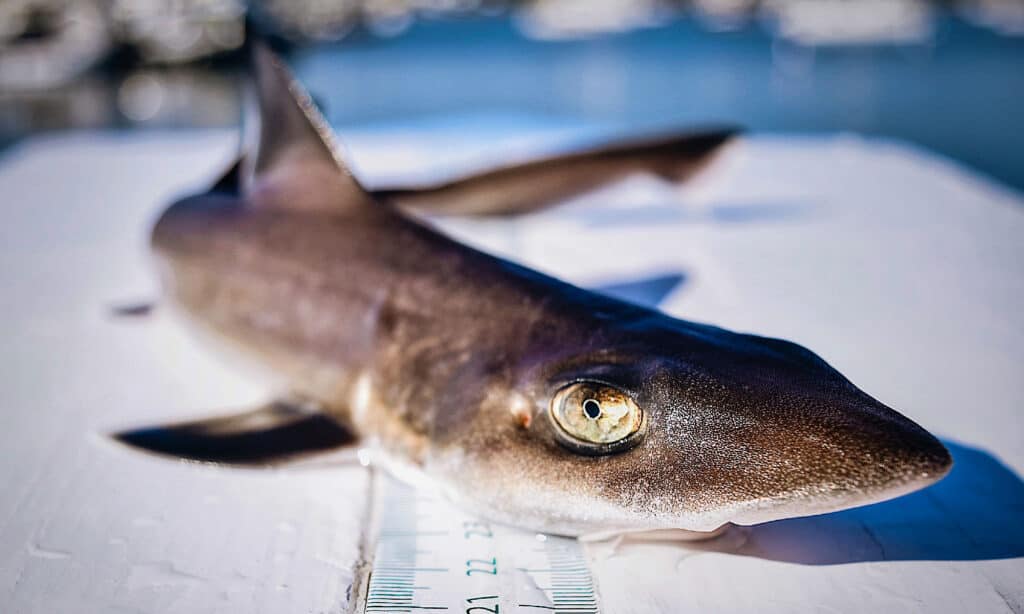
These small sharks kind of look like fish but they are sharks. You might see one in the Chesapeake Bay.
©Rafeed Hussain/Shutterstock.com
The Chesapeake Bay is also a popular area for smooth dogfish, especially in the summer. These small sharks almost look like fish with a long narrow body, but they do have the customary shark dorsal fin. They have cat-like eyes and very unique-looking teeth, especially for a shark. Smooth Dogfish have 8-10 rows of small flat teeth for crushing and grinding their food. Most are around 4 feet long and weigh about 15 lbs. They are not harmful to humans so no worries if you see their small dorsal fin approaching.
3) Atlantic Sharpnose Shark
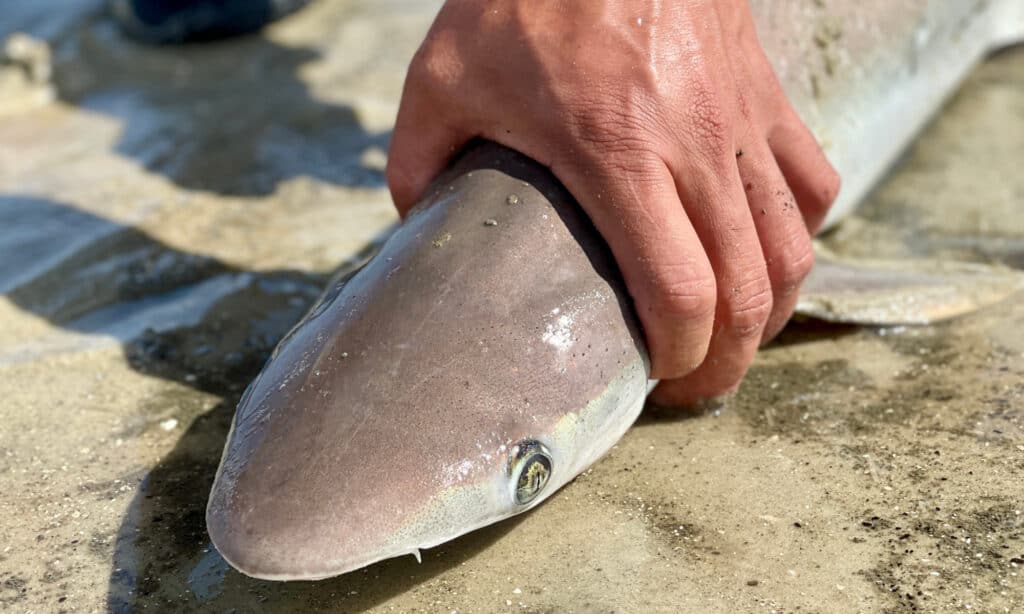
Sharpnose sharks measure only about 3 feet long.
©Finley Del/Shutterstock.com
The Atlantic sharpnose is even smaller than the dogfish, they are between 2 ½ – 3 ½ feet long. Their nose is long and skinny (not as skinny as a dolphin, but narrow for a shark) and they have white spots along their backs. You can find them year-round off South Carolina and south to Florida, but they make their way up to Virginia in the summers. They can be seen near the shoreline so look for the white spots!
4) Dusky Shark
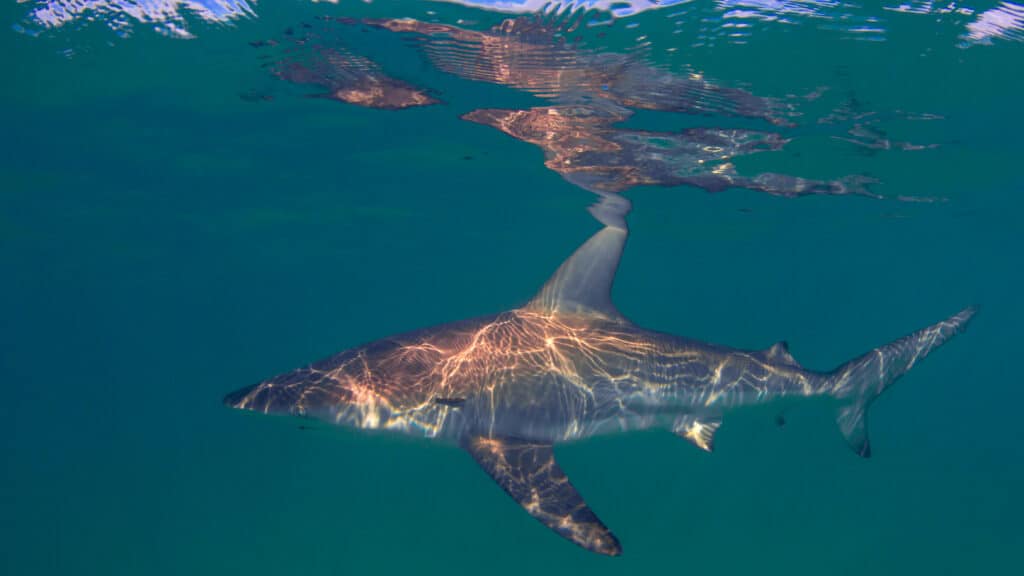
Dusky sharks can get to be 12 feet long!
©Rich Carey/Shutterstock.com
At the other end of the spectrum is the Dusky shark which can get to be 12 feet long and weigh around 750lbs! They swim both near shore and out in deeper water but it is rare to see one off Virginia’s coast and beaches because their numbers are dwindling. They have been victims of overfishing with their fins being very valuable. Conservationists have put regulations in place to limit the fishing of these vulnerable sharks.
5) Blacktip

Blacktip sharks have black tips on their fins making them easy to identify.
©Gino Santa Maria/Shutterstock.com
The blacktip shark is another fairly common shark along the coast of the Atlantic. The average blacktip is around 4 ½ feet long, so a medium-sized shark. They do prefer shallow waters so sightings are more likely and the black tips on their fins make them easier to identify. They can be found as far north as Cape Cod but can be seen all year round off the southern coasts.
6) Spinner

These amazing sharks can leap out of the water and spin around! They hunt in schools so you could see a group of them.
©Jean-Lou Justine / CC BY-SA 3.0 – License
Spinner sharks look a lot like blacktips, with black on their fins and dorsal fin, but they have a unique way to catch their dinner. They swim through a school of fish with their mouths open, collecting as many as they can, then they leap out of the water and spin around, sometimes three times! It is quite a sight to see! They swim in schools so you can imagine multiple sharks jumping out of the water and spinning around, very amazing!
7) Scalloped Hammerhead

Hammerhead sharks
are very unique looking with their eyes on the side of their heads!
©Ian Scott/Shutterstock.com
There are two kinds of hammerhead sharks off Virginia’s coast and beaches. The scalloped and smooth, both names refer to the shape of the “hammer” at the front of the shark’s body! These are crazy-looking sharks that have eyes on the ends of each hammer-shaped head. Their eyesight is actually really good and they use their other senses including detecting electrical currents to find prey. The scalloped hammerhead arrives in Virginia in June and spends the summer before migrating south in August.
8) Smooth Hammerhead

Smooth hammerhead sharks are different than scalloped hammerheads because the front of their heads are smooth-edged.
©iStock.com/Michael Zeigler
Smooth hammerheads are different from scalloped by having a smooth-edged front of their hammerhead. They are 8-11.5 feet long and can reach around 16 feet, so they are a large shark. Smooth hammerheads are much less common off the shores of Virginia but they may be seen in the Lower Chesapeake Bay area or just off the coast in summer and early fall.
9) Bull Shark
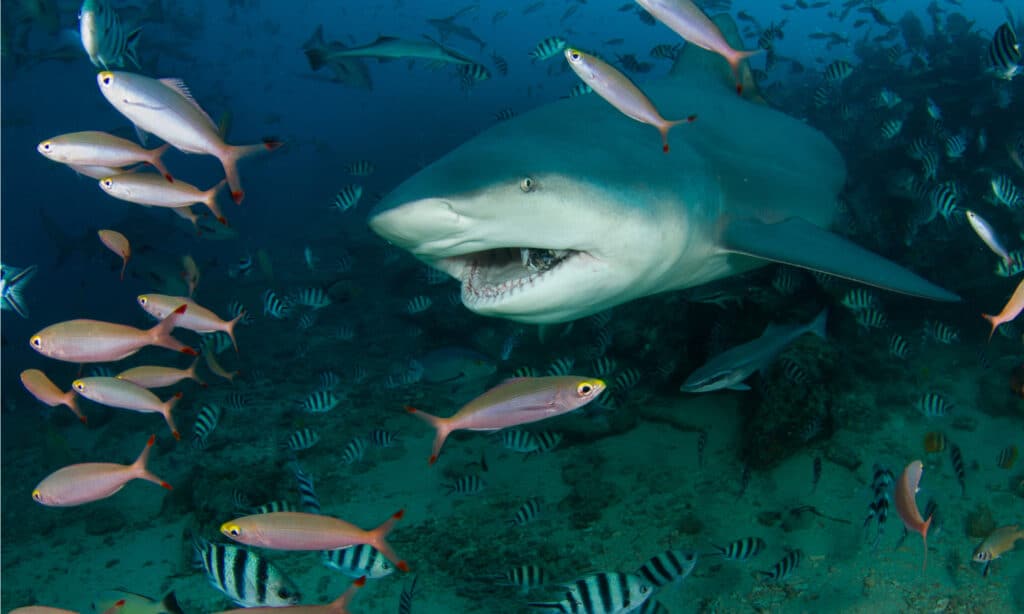
Bull sharks are aggressive sharks. One of the few shark fatalities in Virginia was from a bull shark.
©chatchai kusolsinchai/Shutterstock.com
Bull sharks are aggressive sharks that have been reported as one of the most likely sharks to attack. In fact, it was a bull shark that attacked a 10-year-old boy off Virginia’s coast at Virginia Beach in 2001. David Peltier was surfing with his dad and two brothers when he was attacked and bitten in the leg. His dad fought off the shark and was able to pull his son to shore, but the bite to the leg severed an artery and the boy died at the hospital. Tragic but extremely rare, there have only been 12 unprovoked shark attacks in Virginia since 1852 with three of those being fatal. Bull sharks can get to be 7-11 feet long and can weigh 700 pounds. Dangerous sharks for sure, but also very rare that they have a negative encounter with humans.
10) Tiger Shark
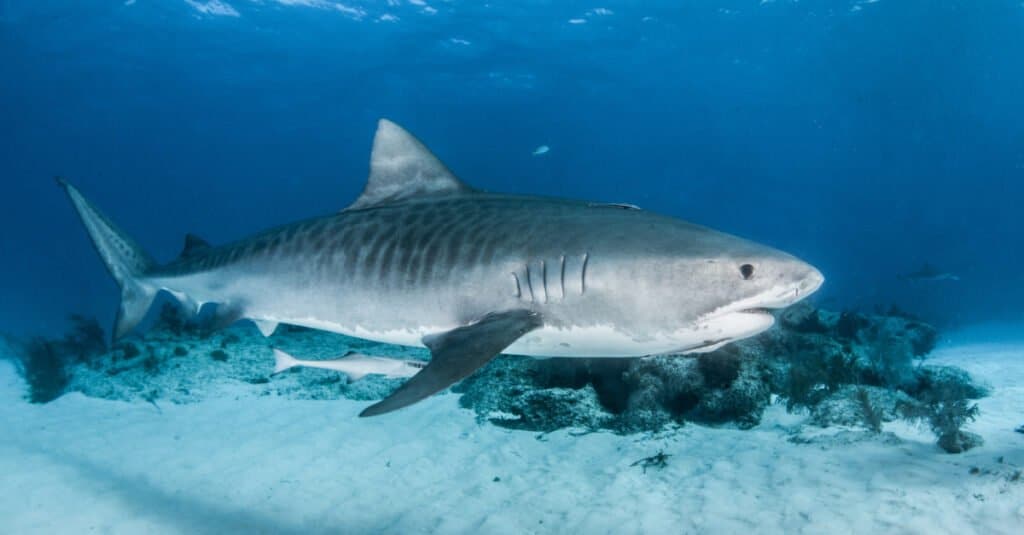
Tiger
sharks have gray stripes on their backs giving them their name. They can get to be 15 feet long and can attack.
©iStock.com/Divepic
The biggest shark off Virginia’s coast and beaches is the Tiger shark; they can get to be 15 feet long!
(It’s worth noting that larger sharks like great whites will pass through, but they’re generally less common.)
Tiger sharks have a unique tiger-striped pattern on their back which makes them easy to identify. They usually prefer deeper waters, 10-20 miles from the shoreline but will occasionally make their way towards the beaches along the shore in Virginia. On September 24, 2010, another shark attack happened at Sandbridge Beach to a surfer. Caleb Kauchek was surfing off of Sandbridge when a shark bit his ankle and knee. He needed 51 stitches to close the wound. Researchers thought it was a blacktip of spinner shark, but tiger sharks are responsible for more attacks so maybe it was a tiger shark!
Summary Of 10 Sharks Near Virginia’s Coast And Beaches
| Rank | Shark |
|---|---|
| 1 | Sandbar Shark |
| 2 | Smooth Dogfish |
| 3 | Atlantic Sharpnose Shark |
| 4 | Duskey Shark |
| 5 | Blacktip Shark |
| 6 | Spinner Shark |
| 7 | Scalloped Hammerhead |
| 8 | Smooth Hammerhead |
| 9 | Bull Shark |
| 10 | Tiger Shark |
The photo featured at the top of this post is © le bouil baptiste/Shutterstock.com
Thank you for reading! Have some feedback for us? Contact the AZ Animals editorial team.






